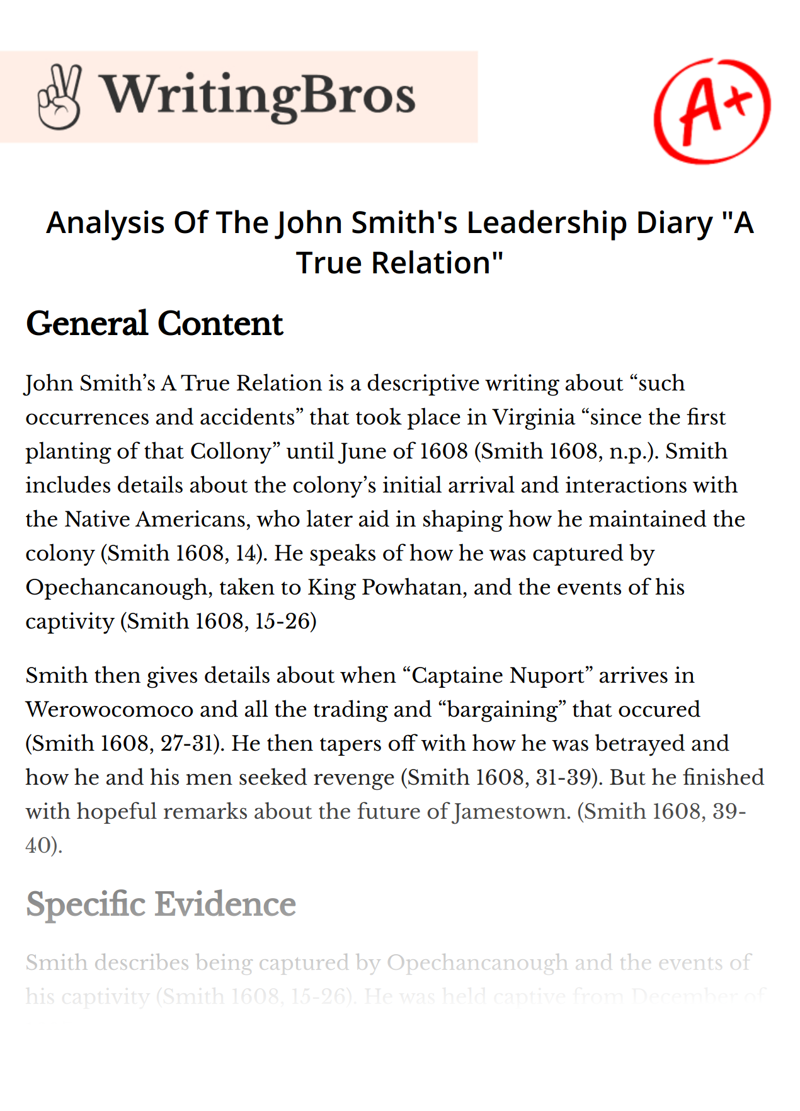Analysis Of The John Smith's Leadership Diary "A True Relation"

Table of contents
General Content
John Smith’s A True Relation is a descriptive writing about “such occurrences and accidents” that took place in Virginia “since the first planting of that Collony” until June of 1608 (Smith 1608, n.p.). Smith includes details about the colony’s initial arrival and interactions with the Native Americans, who later aid in shaping how he maintained the colony (Smith 1608, 14). He speaks of how he was captured by Opechancanough, taken to King Powhatan, and the events of his captivity (Smith 1608, 15-26)
Smith then gives details about when “Captaine Nuport” arrives in Werowocomoco and all the trading and “bargaining” that occured (Smith 1608, 27-31). He then tapers off with how he was betrayed and how he and his men seeked revenge (Smith 1608, 31-39). But he finished with hopeful remarks about the future of Jamestown. (Smith 1608, 39-40).
Specific Evidence
Smith describes being captured by Opechancanough and the events of his captivity (Smith 1608, 15-26). He was held captive from December of 1607 to January of 1608. He recounts being shot in the right leg with an arrow “but without harme (Smith 1608, 15).” With the help of his “hinde [Indian],” Smith was able to communicate to Opechancanough that he was “the Captaine” and that he was there to “to retire to the boate (Smith 1608, 15).” Smith shows signs of anxiousness by stating that everywhere they made a stop, he “expected they would execute” him. Instead, Opechancanough and his 200 men showed mercy to Smith by being kind and showing him a good time (Smith 1608, 16). He describes the King (Powhatan) as being “great” and “kind.” Smith also claims that the king “kindly welcomed” him and “kindly vsed” him (Smith 1608, 19)
Pocahontas was mentioned only briefly. She was sent by her father, Powhatan, at “tenne yeares old” because “certaine Saluages” had been captured (Smith 1608, 38). The text does not mention her in regards to Smith being held captive. Smith described Pocahontas as having “wit” and “spirit” and as being “the only Nonpariel of his [Powhatan’s] Country (Smith 1608, 38).” This means that she was an intelligent young lady with a strong character and she was her father’s favorite.
Publication Context
John Smith wrote A True Relation between April of 1607 and June, during the same time frame that the Virginia Company of London (the Joint Stock Company) was on the rise. The Joint Stock Company sold stock to whoever was willing to buy because they were after gold and silver. Captain Christopher Newport was in charge of the Voyage. Smith gave details about when “Captaine Nuport” arrived in Werowocomoco and described all the “trading” and “bargaining” that occured (Smith 1608, 27-31).
Also during this time colonists were dying of hunger, dehydration, disease, and Native American attacks. Smith specifically mentions a great number of the elder men passing away because of disease (Smith 1608, 23). He also described men being so hopeless and distressed that “they would rather starue and rot with idleness (Smith 1608, 9).” Smith gave details about how the Native Americans “assalted the fort and supprised it Smith 1608, 7).”
Author’s Motivation and Anticipated Audience
John Smith wrote this piece to show that he was a capable leader. He referred to himself as “Captain Smith, Coronell of the said Collony (Smith 1608, n.p.).” This portrays that he was someone of importance and had significant influence over the colonists. Smith was able to read and write which further indicates that he had status. A True Relation is more than just a title. Smith was high lighting that he had a positive effect on the colony and that he was relevant; a true relation. He maintained a relationship with the Native Americans stating the he had “such acquaintance” with them and that they had “such confidence” in him (Smith 1608, 23). He wanted his audience to know that while he was in charge, his men were in “good health,” “wel contended,” and “free of mutinies (Smith 1608, 40).”
Cite this Essay
To export a reference to this article please select a referencing style below

